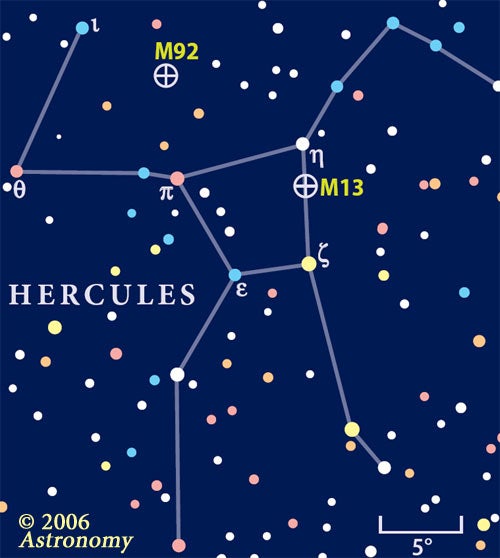Rasalgethi
Rasalgethi, which means “head of the kneeler,” glows with a distinctive reddish twinkle through binoculars. By studying its spectrum, astronomers know Rasalgethi is a red giant star. A view through a telescope reveals Rasalgethi sparkles as a beautiful double star. Its fainter companion lies about 5″ (arcseconds) away. As a variable star, Rasalgethi fluctuates between about 3rd and 4th magnitude during a period of roughly 128 days.
Rasalgethi, which means “head of the kneeler,” glows with a distinctive reddish twinkle through binoculars. By studying its spectrum, astronomers know Rasalgethi is a red giant star. A view through a telescope reveals Rasalgethi sparkles as a beautiful double star. Its fainter companion lies about 5″ (arcseconds) away. As a variable star, Rasalgethi fluctuates between about 3rd and 4th magnitude during a period of roughly 128 days.
NGC 6210
NGC 6210 is bright enough to be seen through most binoculars, but the small size of this planetary nebula can make it difficult to distinguish from the surrounding stars. While the disk’s relative smallness prevents clear resolution, the nebula’s characteristic bluish color helps it stand out in a crowded star field.
NGC 6210 is bright enough to be seen through most binoculars, but the small size of this planetary nebula can make it difficult to distinguish from the surrounding stars. While the disk’s relative smallness prevents clear resolution, the nebula’s characteristic bluish color helps it stand out in a crowded star field.
Dolidze-Dzimselejsvili 9
Dolidze-Dzimselejsvili 9 is a little-known open cluster found in southeastern Hercules less than a degree west of the star 104 Herculis. Binoculars reveal about two-thirds of this group’s 15 stars loosely gathered in a semicircle measuring about half a degree across.
Dolidze-Dzimselejsvili 9 is a little-known open cluster found in southeastern Hercules less than a degree west of the star 104 Herculis. Binoculars reveal about two-thirds of this group’s 15 stars loosely gathered in a semicircle measuring about half a degree across.
The Zigzag
In Touring the Universe through Binoculars, I describe a curious little asterism of a dozen or so faint stars that zigzags across southwestern Hercules. It’s listed in the book as “Harrington 7.” Look for this group about a binocular field (6°) directly south of the star Gamma (γ) Herculis and a third of a field (2°) southwest of Omega (ω) Herculis.
In Touring the Universe through Binoculars, I describe a curious little asterism of a dozen or so faint stars that zigzags across southwestern Hercules. It’s listed in the book as “Harrington 7.” Look for this group about a binocular field (6°) directly south of the star Gamma (γ) Herculis and a third of a field (2°) southwest of Omega (ω) Herculis.










